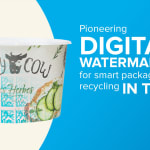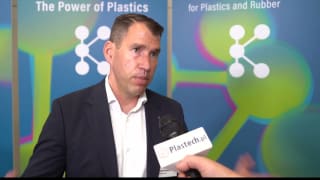
Plastic extrusion technology specialist Reifenhäuser has joined the cross-value chain initiative Digital Watermarks. The project – also known in the industry as HolyGrail 2.0 – was presented to the public today. Under the auspices of AIM, the European Brands Association, 85 companies and organizations from the complete packaging value chain have joined forces with the ambitious goal to assess whether pioneering digital technology can enable better sorting and higher-quality recycling rates for packaging in the EU in order to drive a truly circular economy. Reifenhäuser intends to contribute its expertise regarding the digital documentation of recycling-relevant packaging properties across the entire production process. As a consequence, aligned with the concept of the Digital Watermarks initiative, Reifenhäuser has already developed an open data platform as part of the R-Cycle initiative.
One of the most pressing challenges to achieve a circular economy for packaging is to improve the sorting of post-consumer waste by accurately identifying packaging to achieve more efficient and higher-quality recycling. Digital watermarks may have the potential to revolutionize the way packaging is sorted in the waste management system as it opens new possibilities that are currently not feasible with existing technologies.
“The 3 key ingredients here are innovation, sustainability, and digital, combined to achieve the objective of the EU Green Deal towards a clean, circular and climate neutral economy”, outlines Michelle Gibbons, Director General at AIM. “It is terrific to see such enthusiasm from across the industry and to be able to unite such expertise from the complete packaging value chain, from brand owners and retailers to converters, EPR schemes, waste management systems, recyclers and many more. Collaboration is the way forward to achieve the EU’s circular economy goals.”
Digital watermarks are imperceptible codes that are the size of a postage stamp and cover the surface of a consumer goods packaging. They can carry a wide range of attributes, such as manufacturer, SKU, type of plastics used, and composition for multilayer objects. The aim is that, after the packaging enters a waste sorting facility, the digital watermark is detected and decoded by a standard high-resolution camera on the sorting line. Then – based on the transferred attributes – it is possible to sort the packaging corresponding streams. This would result in better and more accurate sorting streams, and consequently higher-quality recyclates. It would benefit the complete packaging value chain. Besides this “digital recycling passport”, digital watermarks also have potential uses in other areas, such as consumer engagement, supply chain visibility, and retail operations.
R-Cycle: seamless documentation of recycling-relevant packaging properties
Within the R-Cycle consortium, Reifenhäuser is currently working on a digital standard to provide seamless documentation of all recycling-relevant packaging properties based on established tracing technologies. Together with GS1 Germany and other partners from the plastic industry, Reifenhäuser has set up a functioning data platform which is connected to production lines. The technology is tested and demonstrated in a number of pilot projects.
Bernd Reifenhäuser, CEO of the Reifenhäuser Group, explains: “Establishing a true circular economy for plastic packaging is one of the major challenges in our industry. We see a huge potential in Digital Watermarks – HolyGrail 2.0 to create a common approach involving numerous influential companies and organizations. Beyond that, the initiative is logically consistent with our own ideas to improve the recycling process.”
Dr. Benedikt Brenken, head of the R-Cycle initiative, adds: “With R-Cycle, we can make a valuable contribution to Digital Watermarks – HolyGrail 2.0 by providing a tried and tested data platform to collect and store packaging properties behind watermark codes. The key is to define the recycling-relevant data in a global standard and collect this data across the whole value chain.”



